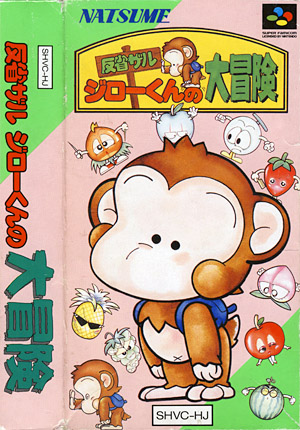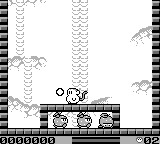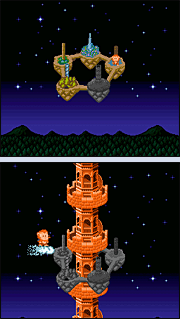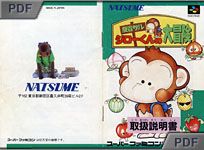HANSEI ZARU JIRŌ-KUN NO DAIBŌKEN
( Spanky's Quest )
|
|

|

|
|
反省ザルジローくんの大冒険
©1991 Natsume
©Wave
Release: 1991-12-27 (¥7000)
Cartridge SHVC-HJ
Puzzle/Platform


|
Released in America as
SPANKY'S QUEST
( SNS-HJ-USA )
|

|
Released in Europe as
SPANKY'S QUEST
( SNSP-HJ-XXX )
|
|
Jirō-kun no Daibōken is an action/platform/puzzle game by Natsume.
The game starts as Jirō-kun (aka Spanky), a cute little monkey, is on
a day trip for a refreshing gourmet picnic. But suddenly, in the middle of a peaceful
forest, a witch appears, imprisons the poor Jirō and steals all the fruits he
was carrying in his backpack. And she has even more sinister plans in store for the
small primate and decides to use her powers to turn all these fruits into evil monsters,
forcing Jirō to use all his wits to escape his dogged pursuers and return home
safely. The aim of each level is to help Jirō locate the exit door in order to
move on to the next stage. However, multiple large locks (one to a maximum of six) keep
it firmly shut, and the monkey must collect all the keys scattered around each level
before seizing a chance to escape. Carrying out that task would be easy, if only it
weren't for the legions of enemies populating the screen. And to defend himself against
these critters, Jirō only comes equipped with possibly the world's most unusual
weapon - bubbles. However, these blue bubbles come with a bit of a twist - if the
player presses the action button again, the bubble pops and releases a small
baseball ball, enough to strike one enemy down. And that's not even half of it!
Jirō can bounce the blue bubble on his head to power it up (from Green,
Yellow to Red) and these new bubbles release even more devastating attacks,
such as lines of soccer balls, spinning volley balls and rows of
basket balls! And the bubbles have a lot more to offer - as such, they can
stun enemies for a while or capture keys or items that Jirō wouldn't be able
to reach otherwise. And the game has a lot of items to collect, such as coins
(points), Extra lives and hats. The latter come in a multitude of forms, from
a Baseball Cap (helps Jirō in controlling the bubbles),
Gold Crown (prevents Jirō to be affected by special platforms, such
as icy surfaces), Top Hat (gives Jirō the ability to instantly grow
a red bubble!), Straw Hat (Jirō can glide in the air after a jump)
and Spiked Helmet (temporary armor against enemies). And Jirō must
always be on his toes, because enemies can also collect items (including keys)
and he will have to battle the foes if they happen to do so! Additionally,
the game is filled with many special and rewarding features, such as
switches (activates traps, such as Fiery Birds or
Fireballs that both Jirō or enemies can operate),
Cannons (throw Jirō and enemies in the air) or hidden
Gold Doors (lead to bonus stages). Jirō-kun no Daibōken
consists of five large areas of ten levels each, all punctuated by a
requisite boss battle. Each zone also features a three-digit password
system to save the player's progress.
|
 Interestingly, Jirō-kun no Daibōken was first released in 1991 as a
Game Boy game (picture on the left) called Lucky Monkey in Japan
(and Spanky's Quest in the rest of the world). However,
although the game is similar to the Super Famicom version tested here
(they do share the same theme), both games have
notable differences - the levels as well as some of the enemies and
bosses are slightly different, and the game doesn't require the player to collect
keys, but to clear each level of its enemies instead. Finally, the way to
pop the bubbles is different - the player has to press and hold up
to burst a bubble, making the game slightly more difficult
to play. The game also features letters to collect in order to
access the bonus stages (the letters spell 'MONKEY'
in the Japanese version and 'SPANKY' in the western port).
Finally, Lucky Monkey doesn't seem to
feature power hats nor sport balls, and bubbles split instead into
black balls.
Interestingly, Jirō-kun no Daibōken was first released in 1991 as a
Game Boy game (picture on the left) called Lucky Monkey in Japan
(and Spanky's Quest in the rest of the world). However,
although the game is similar to the Super Famicom version tested here
(they do share the same theme), both games have
notable differences - the levels as well as some of the enemies and
bosses are slightly different, and the game doesn't require the player to collect
keys, but to clear each level of its enemies instead. Finally, the way to
pop the bubbles is different - the player has to press and hold up
to burst a bubble, making the game slightly more difficult
to play. The game also features letters to collect in order to
access the bonus stages (the letters spell 'MONKEY'
in the Japanese version and 'SPANKY' in the western port).
Finally, Lucky Monkey doesn't seem to
feature power hats nor sport balls, and bubbles split instead into
black balls.
|
 Beyond the questionable name choice, there are some interesting (and surprising)
differences between the original Super Famicom version tested here, and the
version called Spanky's Quest released later in the United States and Europe. For some obscure
reasons, the title screen was entirely changed. Then, the first world from the
Japanese game has instructions in the background that guide the player
through the gameplay system - this feature was entirely omitted from the western
release. However, the western game has the currently visited area indicated in
large prints in the top-right corner of the screen (this part is a lot more
subtle in the Japanese version). Additionally, the Japanese
version has a world map (picture on the top-right) that shows the various zones of the game - and this
too was surprisingly removed (which is rather odd, this part of the game
doesn't even display any Japanese text). Finally, the western version
has an introduction sequence (that can't be skipped!) curiously not included in the Japanese
release, whereas the latter features an animated sequence right before the
last area (picture on the bottom-right) as well as an ending sequence not included in the
western version! There are probably a lot more subtle differences between the
two versions, but it is anyone's guess as to why the game was substantially
modified for the western release...
Beyond the questionable name choice, there are some interesting (and surprising)
differences between the original Super Famicom version tested here, and the
version called Spanky's Quest released later in the United States and Europe. For some obscure
reasons, the title screen was entirely changed. Then, the first world from the
Japanese game has instructions in the background that guide the player
through the gameplay system - this feature was entirely omitted from the western
release. However, the western game has the currently visited area indicated in
large prints in the top-right corner of the screen (this part is a lot more
subtle in the Japanese version). Additionally, the Japanese
version has a world map (picture on the top-right) that shows the various zones of the game - and this
too was surprisingly removed (which is rather odd, this part of the game
doesn't even display any Japanese text). Finally, the western version
has an introduction sequence (that can't be skipped!) curiously not included in the Japanese
release, whereas the latter features an animated sequence right before the
last area (picture on the bottom-right) as well as an ending sequence not included in the
western version! There are probably a lot more subtle differences between the
two versions, but it is anyone's guess as to why the game was substantially
modified for the western release...
|
Teaser text from the American version:
Wicked witch turns fruits into monsters,
Mopoland Population famished!
Welcome to Mopoland, where the evil witch Morticia
has cast an evil spell and turned all the fruits of the
mighty kingdom into fiendish monsters. Spanky, our
primate hero is on a quest. Armed with his magic
ball, and his exceptional ball heading capabilities,
Spanky must hunt down Morticia through six gruelling
levels to liberate Mopoland, and save it's citizens
from a certain famine.
|
Game Staff (Copied from the American version's end credits) :
|
STAFF
Game Planner
S. Ominami
Programmer
S. Yosikawa
K, Furuya
A. Isizuka
|
|
Sound
K. Sada
Character Design
Y. Ogawa
K. Sino
T. Fujituna
J. Kobayasi
|
|
Advisor
T. Suzuki
Special Thanks
Jim H. Yajima
Michael Maubry
|
|
This game was developed
and presented to
you by NATSUME Inc.
The End.
|
|
O
M
A
K
E
|
|

|
|
|
Click on picture to enlarge |
S
E
C
R
E
T
S
|
|
Level Passwords:
Both Japanese and Western releases of the game
share the same level passwords:
Zone 1 - 000
Zone 2 - 732
Zone 3 - 354
Zone 4 - 116
Zone 5 - 988
Zone 6 - 470
|
|
|
|
|
|
LK

|
|
Add your Pov here !
|
P
O
V
s
|
|
Jirō-kun no Daibōken is really a game that took me by surprise - and
a really pleasant surprise that was. I personally love the cute and extremely
polished graphics - Jirō looks great with an ever-present attention to
detail. The same applies to enemies, and although there are only a handful of
them in the whole game, they are all full of life and really fun overall. The
catchy music is also excellent and fits the mood of the game very well. But it's
in the gameplay department that Jirō-kun no Daibōken really
shines - bubbles take a bit of time to get used to, but when you do, you will
be breezing through the levels and evading enemies with ease. The game is a
very fun ride from beginning to end and it definitively has that familiar
'just one more level' thing going for it. I was incredibly surprised by the
depth of the gameplay - for instance, bubbles can be used to kill enemies but
they can also fetch items that are hard to reach, or reveal bonus stages! And
as the game progresses, you discover new unique ideas (such as switches that
activate traps, cannons or conveyor belts) that manage to keep the gameplay
fresh. All in all, Jirō-kun no Daibōken is absolutely delightful and
fun, and is definitively an overlooked game that deserves more merit than it has.
|
|
|
|